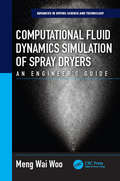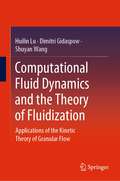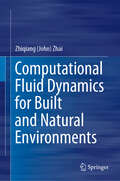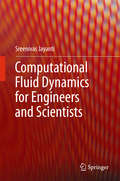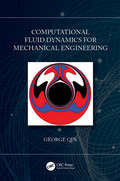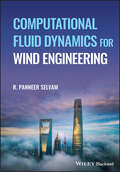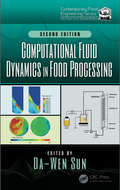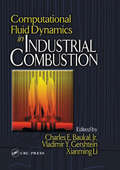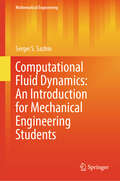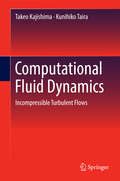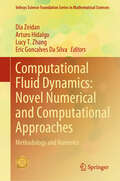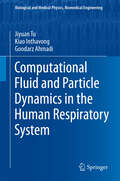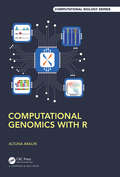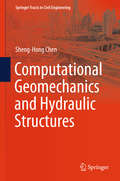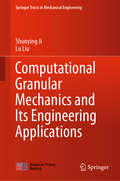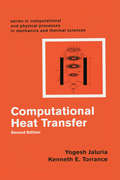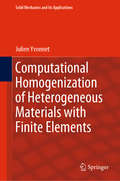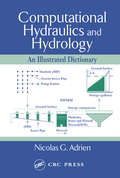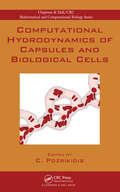- Table View
- List View
Computational Fluid Dynamics Simulation of Spray Dryers: An Engineer’s Guide (Advances in Drying Science and Technology #Vol. 2)
by Meng Wai WooBridging the gap in understanding between the spray drying industry and the numerical modeler on spray drying, Computational Fluid Dynamics Simulation of Spray Dryers: An Engineer’s Guide shows how to numerically capture important physical phenomena within a spray drying process using the CFD technique. It includes numerical strategies to effectively describe these phenomena, which are collated from research work and CFD industrial consultation, in particular to the dairy industry. Along with showing how to set up models, the book helps readers identify the capabilities and uncertainties of the CFD technique for spray drying. After briefly covering the basics of CFD, the book discusses airflow modeling, atomization and particle tracking, droplet drying, quality modeling, agglomeration and wall deposition modeling, and simulation validation techniques. The book also answers questions related to common challenges in industrial applications.
Computational Fluid Dynamics and Heat Transfer (Series In Computational And Physical Processes In Mechanics And Thermal Sciences Ser.)
by Pradip MajumdarThis book provides a thorough understanding of fluid dynamics and heat and mass transfer. The Second Edition contains new chapters on mesh generation and computational modeling of turbulent flow. Combining theory and practice in classic problems and computer code, the text includes numerous worked-out examples. Students will be able to develop computational analysis models for complex problems more efficiently using commercial codes such as ANSYS, STAR CCM+, and COMSOL. With detailed explanations on how to implement computational methodology into computer code, students will be able to solve complex problems on their own and develop their own customized simulation models, including problems in heat transfer, mass transfer, and fluid flows. These problems are solved and illustrated in step-by-step derivations and figures. FEATURES Provides unified coverage of computational heat transfer and fluid dynamics Covers basic concepts and then applies computational methods for problem analysis and solution Covers most common higher-order time-approximation schemes Covers most common and advanced linear solvers Contains new chapters on mesh generation and computer modeling of turbulent flow Computational Fluid Dynamics and Heat Transfer, Second Edition, is valuable to engineering instructors and students taking courses in computational heat transfer and computational fluid dynamics.
Computational Fluid Dynamics and its Applications in Echinoderm Palaeobiology (Elements of Paleontology)
by Imran A. RahmanComputational fluid dynamics (CFD), which involves using computers to simulate fluid flow, is emerging as a powerful approach for elucidating the palaeobiology of ancient organisms. Here, Imran A. Rahman describes its applications for studying fossil echinoderms. When properly configured, CFD simulations can be used to test functional hypotheses in extinct species, informing on aspects such as feeding and stability. They also show great promise for addressing ecological questions related to the interaction between organisms and their environment. CFD has the potential to become an important tool in echinoderm palaeobiology over the coming years.
Computational Fluid Dynamics and the Theory of Fluidization: Applications of the Kinetic Theory of Granular Flow
by Dimitri Gidaspow Huilin Lu Shuyan WangThis book is for engineers and students to solve issues concerning the fluidized bed systems. It presents an analysis that focuses directly on the problem of predicting the fluid dynamic behavior which empirical data is limited or unavailable. The second objective is to provide a treatment of computational fluidization dynamics that is readily accessible to the non-specialist. The approach adopted in this book, starting with the formulation of predictive expressions for the basic conservation equations for mass and momentum using kinetic theory of granular flow. The analyses presented in this book represent a body of simulations and experiments research that has appeared in numerous publications over the last 20 years. This material helps to form the basis for university course modules in engineering and applied science at undergraduate and graduate level, as well as focused, post-experienced courses for the process, and allied industries.
Computational Fluid Dynamics for Built and Natural Environments
by Zhiqiang (John) ZhaiThis book introduces readers to the fundamentals of simulating and analyzing built and natural environments using the Computational Fluid Dynamics (CFD) method. CFD offers a powerful tool for dealing with various scientific and engineering problems and is widely used in diverse industries. This book focuses on the most important aspects of applying CFD to the study of urban, buildings, and indoor and outdoor environments. Following the logical procedure used to prepare a CFD simulation, the book covers e.g. the governing equations, boundary conditions, numerical methods, modeling of different fluid flows, and various turbulence models. Furthermore, it demonstrates how CFD can be applied to solve a range of engineering problems, providing detailed hands-on exercises on air and water flow, heat transfer, and pollution dispersion problems that typically arise in the study of buildings and environments. The book also includes practical guidance on analyzing and reporting CFD results, as well as writing CFD reports/papers.
Computational Fluid Dynamics for Engineers
by Mikael Mortensen Love Håkansson Ronnie Andersson Bengt Andersson Berend Van Wachem Rahman SudiyoComputational fluid dynamics, CFD, has become an indispensable tool for many engineers. This book gives an introduction to CFD simulations of turbulence, mixing, reaction, combustion and multiphase flows. The emphasis on understanding the physics of these flows helps the engineer to select appropriate models to obtain reliable simulations. Besides presenting the equations involved, the basics and limitations of the models are explained and discussed. The book combined with tutorials, project and power-point lecture notes (all available for download) forms a complete course. The reader is given hands-on experience of drawing, meshing and simulation. The tutorials cover flow and reactions inside a porous catalyst, combustion in turbulent non-premixed flow, and multiphase simulation of evaporation spray respectively. The project deals with design of an industrial-scale selective catalytic reduction process and allows the reader to explore various design improvements and apply best practice guidelines in the CFD simulations.
Computational Fluid Dynamics for Engineers and Scientists
by Sreenivas JayantiThis book offers a practical, application-oriented introduction to computational fluid dynamics (CFD), with a focus on the concepts and principles encountered when using CFD in industry. Presuming no more knowledge than college-level understanding of the core subjects, the book puts together all the necessary topics to give the reader a comprehensive introduction to CFD. It includes discussion of the derivation of equations, grid generation and solution algorithms for compressible, incompressible and hypersonic flows. The final two chapters of the book are intended for the more advanced user. In the penultimate chapter, the special difficulties that arise while solving practical problems are addressed. Distinction is made between complications arising out of geometrical complexity and those arising out of the complexity of the physics (and chemistry) of the problem. The last chapter contains a brief discussion of what can be considered as the Holy Grail of CFD, namely, finding the optimal design of a fluid flow component. A number of problems are given at the end of each chapter to reinforce the concepts and ideas discussed in that chapter. CFD has come of age and is widely used in industry as well as in academia as an analytical tool to investigate a wide range of fluid flow problems. This book is written for two groups: for those students who are encountering CFD for the first time in the form of a taught lecture course, and for those practising engineers and scientists who are already using CFD as an analysis tool in their professions but would like to deepen and broaden their understanding of the subject.
Computational Fluid Dynamics for Mechanical Engineering
by George QinThis textbook presents the basic methods, numerical schemes, and algorithms of computational fluid dynamics (CFD). Readers will learn to compose MATLAB® programs to solve realistic fluid flow problems.Newer research results on the stability and boundedness of various numerical schemes are incorporated. The book emphasizes large eddy simulation (LES) in the chapter on turbulent flow simulation besides the two-equation models. Volume of fraction (VOF) and level-set methods are the focus of the chapter on two-phase flows.The textbook was written for a first course in computational fluid dynamics (CFD) taken by undergraduate students in a Mechanical Engineering major.Access the Support Materials: https://www.routledge.com/9780367687298.
Computational Fluid Dynamics for Wind Engineering
by R. Panneer SelvamCOMPUTATIONAL FLUID DYNAMICS FOR WIND ENGINEERING An intuitive and comprehensive exploration of computational fluid dynamics in the study of wind engineering Computational Fluid Dynamics for Wind Engineering provides readers with a detailed overview of the use of computational fluid dynamics (CFD) in understanding wind loading on structures, a problem becoming more pronounced as urban density increases and buildings become larger. The work emphasizes the application of CFD to practical problems in wind loading and helps readers understand important associated factors such as turbulent flow around buildings and bridges. The author, with extensive research experience in this and related fields, offers relevant and engaging practice material to help readers learn and retain the concepts discussed, and each chapter includes accessible summaries at the end. In addition, the use of the OpenFOAM tool—an open-source wind engineering application—is explored. Computational Fluid Dynamics for Wind Engineering covers topics such as: Fluid mechanics, turbulence in fluid mechanics, turbulence modelling, and mathematical modelling of wind engineering problems The finite difference method for CFD, solutions to the incompressible Navier-Stokes equations, visualization, and animation in CFD, and the application of CFD to building and bridge aerodynamics How to compare CFD analysis with wind tunnel measurements, field measurements, and the ASCE-7 pressure coefficients Wind effects and strain on large structures Providing comprehensive coverage of how CFD can explain wind load on structures along with helpful examples of practical applications, Computational Fluid Dynamics for Wind Engineering serves as an invaluable resource for senior undergraduate students, graduate students, researchers and practitioners of civil and structural engineering.
Computational Fluid Dynamics in Food Processing (Contemporary Food Engineering)
by Da-Wen SunSince many processes in the food industry involve fluid flow and heat and mass transfer, Computational Fluid Dynamics (CFD) provides a powerful early-stage simulation tool for gaining a qualitative and quantitative assessment of the performance of food processing, allowing engineers to test concepts all the way through the development of a process or system. <P><P>Published in 2007, the first edition was the first book to address the use of CFD in food processing applications, and its aims were to present a comprehensive review of CFD applications for the food industry and pinpoint the research and development trends in the development of the technology; to provide the engineer and technologist working in research, development, and operations in the food industry with critical, comprehensive, and readily accessible information on the art and science of CFD; and to serve as an essential reference source to undergraduate and postgraduate students and researchers in universities and research institutions. This will continue to be the purpose of this second edition. <P><P>In the second edition, in order to reflect the most recent research and development trends in the technology, only a few original chapters are updated with the latest developments. Therefore, this new edition mostly contains new chapters covering the analysis and optimization of cold chain facilities, simulation of thermal processing and modeling of heat exchangers, and CFD applications in other food processes.
Computational Fluid Dynamics in Industrial Combustion
by Charles E. Baukal Vladimir Y. Cershtein Xianming LiAlthough many books have been written on computational fluid dynamics (CFD) and many written on combustion, most contain very limited coverage of the combination of CFD and industrial combustion. Furthermore, most of these books are written at an advanced academic level, emphasize theory over practice, and provide little help to engineers who need
Computational Fluid Dynamics: An Introduction for Mechanical Engineering Students (Mathematical Engineering)
by Sergei S. SazhinThis book introduces the basic concepts of the Computational Fluid Dynamics (CFD) of single-phase and multiphase flows. While the opening chapter focuses on the key equations that are solved numerically using classical CFD codes, the intention is not just to show these equations, but also to present key ideas of the calculus on which the formulations of these equations, and the analysis of other parts of the book, are based. Various approaches to the discretisation of conservation equations describing single-phase flows and the methods for solving the algebraic equations are demonstrated, including the details of some derivations usually omitted in classical textbooks. Also, the details of the SIMPLE algorithm is described. In contrast to most classical CFD books, this textbook also develops the basic principles of modelling multiphase flows, including approaches to modelling spray formation and droplet dynamics, analyses of flow instabilities, and droplet heating and evaporation. Completing the coverage, approaches to modelling the processes in multicomponent droplets, including puffing and micro-explosion in composite droplets, are discussed and the modelling of thermal radiation transfer using CFD codes is treated.
Computational Fluid Dynamics: Incompressible Turbulent Flows
by Takeo Kajishima Kunihiko TairaThis textbook presents numerical solution techniques for incompressible turbulent flows that occur in a variety of scientific and engineering settings including aerodynamics of ground-based vehicles and low-speed aircraft, fluid flows in energy systems, atmospheric flows, and biological flows. This book encompasses fluid mechanics, partial differential equations, numerical methods, and turbulence models, and emphasizes the foundation on how the governing partial differential equations for incompressible fluid flow can be solved numerically in an accurate and efficient manner. Extensive discussions on incompressible flow solvers and turbulence modeling are also offered. This text is an ideal instructional resource and reference for students, research scientists, and professional engineers interested in analyzing fluid flows using numerical simulations for fundamental research and industrial applications.
Computational Fluid Dynamics: Methodology and Numerics (Infosys Science Foundation Series)
by Dia Zeidan Lucy T. Zhang Eric Goncalves Da Silva Arturo HidalgoThis book reveals the latest research outputs in computational fluid dynamics. It contains selected chapters on fluid flow problems authored by international researchers. It highlights the current trends in the modelling and simulation aspects of fluid dynamics. Even though modelling and simulations in fluid dynamics are now considered mainstream in analysing fluid flows, heat and mass transfer problems, researchers are still exploring various numerical approaches and recipes to achieve better accuracy and efficiency for challenging applications in biomedical, aerospace, renewable energy and other industrial engineering applications. The book aims to bring many of the diverse modelling and simulation tools in one place and to advance existing progress in the emerging sciences of fluid dynamics. It summarizes current mathematical and physical modelling approaches as well as computational techniques applicable to fluid dynamics. The book would be of special interest to physicists and researchers in several fields related to computational, applied sciences and engineering.
Computational Fluid and Particle Dynamics in the Human Respiratory System (Biological and Medical Physics, Biomedical Engineering)
by Goodarz Ahmadi Jiyuan Tu Kiao InthavongTraditional research methodologies in the human respiratory system have always been challenging due to their invasive nature. Recent advances in medical imaging and computational fluid dynamics (CFD) have accelerated this research. This book compiles and details recent advances in the modelling of the respiratory system for researchers, engineers, scientists, and health practitioners. It breaks down the complexities of this field and provides both students and scientists with an introduction and starting point to the physiology of the respiratory system, fluid dynamics and advanced CFD modeling tools. In addition to a brief introduction to the physics of the respiratory system and an overview of computational methods, the book contains best-practice guidelines for establishing high-quality computational models and simulations. Inspiration for new simulations can be gained through innovative case studies as well as hands-on practice using pre-made computational code. Last but not least, students and researchers are presented the latest biomedical research activities, and the computational visualizations will enhance their understanding of physiological functions of the respiratory system.
Computational Gasdynamics
by Culbert B. LaneyNumerical methods are indispensable tools in the analysis of complex fluid flows. This book focuses on computational techniques for high-speed gas flows, especially gas flows containing shocks and other steep gradients. The book decomposes complicated numerical methods into simple modular parts, showing how each part fits and how each method relates to or differs from others. The text begins with a review of gasdynamics and computational techniques. Next come basic principles of computational gasdynamics. The last two parts cover basic techniques and advanced techniques. Senior and graduate level students, especially in aerospace engineering, as well as researchers and practising engineers, will find a wealth of invaluable information on high-speed gas flows in this text.
Computational Genomics with R (Chapman & Hall/CRC Computational Biology Series)
by Altuna AkalinComputational Genomics with R provides a starting point for beginners in genomic data analysis and also guides more advanced practitioners to sophisticated data analysis techniques in genomics. The book covers topics from R programming, to machine learning and statistics, to the latest genomic data analysis techniques. The text provides accessible information and explanations, always with the genomics context in the background. This also contains practical and well-documented examples in R so readers can analyze their data by simply reusing the code presented. As the field of computational genomics is interdisciplinary, it requires different starting points for people with different backgrounds. For example, a biologist might skip sections on basic genome biology and start with R programming, whereas a computer scientist might want to start with genome biology. After reading: You will have the basics of R and be able to dive right into specialized uses of R for computational genomics such as using Bioconductor packages. You will be familiar with statistics, supervised and unsupervised learning techniques that are important in data modeling, and exploratory analysis of high-dimensional data. You will understand genomic intervals and operations on them that are used for tasks such as aligned read counting and genomic feature annotation. You will know the basics of processing and quality checking high-throughput sequencing data. You will be able to do sequence analysis, such as calculating GC content for parts of a genome or finding transcription factor binding sites. You will know about visualization techniques used in genomics, such as heatmaps, meta-gene plots, and genomic track visualization. You will be familiar with analysis of different high-throughput sequencing data sets, such as RNA-seq, ChIP-seq, and BS-seq. You will know basic techniques for integrating and interpreting multi-omics datasets. Altuna Akalin is a group leader and head of the Bioinformatics and Omics Data Science Platform at the Berlin Institute of Medical Systems Biology, Max Delbrück Center, Berlin. He has been developing computational methods for analyzing and integrating large-scale genomics data sets since 2002. He has published an extensive body of work in this area. The framework for this book grew out of the yearly computational genomics courses he has been organizing and teaching since 2015.
Computational Geomechanics and Hydraulic Structures (Springer Tracts in Civil Engineering)
by Sheng-Hong ChenThis book presents recent research into developing and applying computational tools to estimate the performance and safety of hydraulic structures from the planning and construction stage to the service period. Based on the results of a close collaboration between the author and his colleagues, friends, students and field engineers, it shows how to achieve a good correlation between numerical computation and the actual in situ behavior of hydraulic structures. The book’s heuristic and visualized style disseminates the philosophy and road map as well as the findings of the research. The chapters reflect the various aspects of the three typical and practical methods (the finite element method, the block element method, the composite element method) that the author has been working on and made essential contributions to since the 1980s. This book is an advanced continuation of Hydraulic Structures by the same author, published by Springer in 2015.
Computational Geomechanics: Theory and Applications
by Manuel Pastor Andrew H. Chan Bernhard A. Schrefler Tadahiko Shiomi Olgierd C. ZienkiewiczCOMPUTATIONAL GEOMECHANICS The new edition of the first book to cover the computational dynamic aspects of geomechanics, now including more practical applications and up-to-date coverage of current research in the field Advances in computational geomechanics have dramatically improved understanding of the behavior of soils and the ability of engineers to design increasingly sophisticated constructions in the ground. When Professor Olek Zienkiewicz began the application of numerical approaches to solid dynamics at Swansea University, it became evident that realistic prediction of the behavior of soil masses could only be achieved if the total stress approaches were abandoned. Computational Geomechanics introduces the theory and application of Zienkiewicz’s computational approaches that remain the basis for work in the area of saturated and unsaturated soil to this day. Written by past students and colleagues of Professor Zienkiewicz, this extended Second Edition provides formulations for a broader range of problems, including failure load under static loading, saturated and unsaturated consolidation, hydraulic fracturing, and liquefaction of soil under earthquake loading. The internationally-recognized team of authors incorporates current computer technologies and new developments in the field, particularly in the area of partial saturation, as they guide readers on how to properly apply the formulation in their work. This one-of-a-kind volume: Explains the Biot-Zienkiewicz formulation for saturated and unsaturated soil Covers multiple applications to static and dynamic problems for saturated and unsaturated soil in areas such as earthquake engineering and fracturing of soils and rocks Features a completely new chapter on fast catastrophic landslides using depth integrated equations and smoothed particle hydrodynamics with applications Presents the theory of porous media in the saturated and unsaturated states to establish the foundation of the problem of soil mechanics Provides a quantitative description of soil behavior including simple plasticity models, generalized plasticity, and critical state soil mechanics Includes numerous questions, problems, hands-on experiments, applications to other situations, and example code for GeHoMadrid Computational Geomechanics: Theory and Applications, Second Edition is an ideal textbook for specialist and general geotechnical postgraduate courses, and a must-have reference for researchers in geomechanics and geotechnical engineering, for software developers and users of geotechnical finite element software, and for geotechnical analysts and engineers making use of the numerical results obtained from the Biot-Zienkiewicz formulation.
Computational Granular Mechanics and Its Engineering Applications (Springer Tracts in Mechanical Engineering)
by Lu Liu Shunying JiThis book systematically introduces readers to computational granular mechanics and its relative engineering applications. Part I describes the fundamentals, such as the generation of irregular particle shapes, contact models, macro-micro theory, DEM-FEM coupling, and solid-fluid coupling of granular materials. It also discusses the theory behind various numerical methods developed in recent years. Further, it provides the GPU-based parallel algorithm to guide the programming of DEM and examines commercial and open-source codes and software for the analysis of granular materials. Part II focuses on engineering applications, including the latest advances in sea-ice engineering, railway ballast dynamics, and lunar landers. It also presents a rational method of parameter calibration and thorough analyses of DEM simulations, which illustrate the capabilities of DEM. The computational mechanics method for granular materials can be applied widely in various engineering fields, such as rock and soil mechanics, ocean engineering and chemical process engineering.
Computational Heat Transfer (Series In Computational And Physical Processes In Mechanics And Thermal Sciences Ser.)
by Yogesh JaluriaThis new edition updated the material by expanding coverage of certain topics, adding new examples and problems, removing outdated material, and adding a computer disk, which will be included with each book. Professor Jaluria and Torrance have structured a text addressing both finite difference and finite element methods, comparing a number of applicable methods.
Computational Homogenization of Heterogeneous Materials with Finite Elements (Solid Mechanics and Its Applications #258)
by Julien YvonnetThis monograph provides a concise overview of the main theoretical and numerical tools to solve homogenization problems in solids with finite elements. Starting from simple cases (linear thermal case) the problems are progressively complexified to finish with nonlinear problems. The book is not an overview of current research in that field, but a course book, and summarizes established knowledge in this area such that students or researchers who would like to start working on this subject will acquire the basics without any preliminary knowledge about homogenization. More specifically, the book is written with the objective of practical implementation of the methodologies in simple programs such as Matlab. The presentation is kept at a level where no deep mathematics are required.
Computational Hydraulics and Hydrology: An Illustrated Dictionary
by Nicolas G. AdrienComputational hydraulics and hydrologic modeling are rapidly developing fields with a wide range of applications in areas ranging from wastewater disposal and stormwater management to civil and environmental engineering. These fields are full of promise, but the abundance of literature that now exists contains many new terms that are not always def
Computational Hydrodynamics of Capsules and Biological Cells (Chapman & Hall/CRC Computational Biology Series)
by C. PozrikidisSpanning biological, mathematical, computational, and engineering sciences, computational biofluiddynamics addresses a diverse family of problems involving fluid flow inside and around living organisms, organs, tissue, biological cells, and other biological materials. Computational Hydrodynamics of Capsules and Biological Cells provides a comprehen
Computational Immunology: Applications
by Shyamasree GhoshComputational Immunology: Applications focuses on different mathematical models, statistical tools, techniques, and computational modelling that helps in understanding complex phenomena of the immune system and its biological functions. The book also focuses on the latest developments in computational biology in designing of drugs, targets, biomarkers for early detection and prognosis of a disease. It highlights the applications of computational methods in deciphering the complex processes of the immune system and its role in health and disease. This book discusses the most essential topics, including Next generation sequencing (NGS) and computational immunology Computational modelling and biology of diseases Drug designing Computation and identification of biomarkers Application in organ transplantation Application in disease detection and therapy Computational methods and applications in understanding of the invertebrate immune system Shyamasree Ghosh (MSc, PhD, PGDHE, PGDBI) Scientific Officer (F), is currently working in the School of Biological Sciences, National Institute of Science Education and Research (NISER), Bhubaneswar, DAE, Govt of India, graduated from the prestigious Presidency College Kolkata in 1998. She was awarded the prestigious National Scholarship from the Government of India. She has worked and published extensively in glycobiology, sialic acids, immunology, stem cells and nanotechnology. She has authored several publications that include books and encyclopedia chapters in reputed journals and books.
